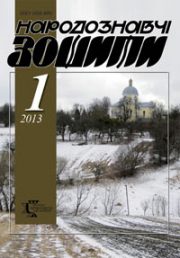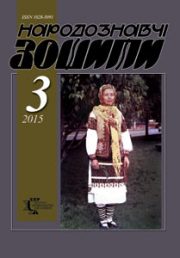The Ethnology Notebooks. 2017, 2 (134), 311—318.
UDK 39:746.7(477.86)
DOI https://doi.org/10.15407/nz2017.02.311
THE WEAVING AT POKUTTIA (WILLOW WEAVING, BASKET WEAVING, BRUSH WEAVING)
Taras Yaroslav, doctor of History, professor, Candidate of Sciences in
in the Department of of the modern ethnology
of the Institute of Ethnology of the National Academy of Sciences of Ukraine.
Svobody Avenue 15, 79000, Lviv, Ukraine.
Contacts: e-mail: etnomod@ukr.net
Professor
National University “Lviv Polytechnic”
Department of Restoration and Reconstruction of Architecture and Art Monuments
Contacts: e-mail: etnomod@ukr.net
ORCID ID: https://orcid.org/0000-0001-7241-9466
Abstract. The history of willow weaving at Pokuttia and its application into the folk building and enclosing; producing of household and sacral objects, furniture, fishing tackles are under consideration; particular attention is paid to basket weaving, masters of willow weaving, factors, which assists to its spreading — schools of basket weaving. Weaving from straw, sedge, product assortment and brush weaving are highlighted.
Keywords: Pokuttia, willow weaving, basket weaving, brush weaving.
Received 03.02.2017
REFERENCES
Archive of the Institute of Ethnology of the National Academy of Sciences of Ukraine. F. 1. [in Ukrainian].
TsDIA Ukrainy u L’vovi. F. 159. Op. 9. [in Ukrainian].
Bazhans’kyj, M. (1982). Krasa Sniatynschyny. Riky, potoky, lisy, luhy, sady, mista i sela ta vysoka material’na i dukhovna kul’tura ikhnikh zhyteliv: Haslova entsyklopediia. Ditrojt [in Ukrainian].
Bachyns’kyj, M. (1978). Serafyntsi. In Horodenschyna. Istorychno-memuarnyj zbirnyk. (Vol. 1). N’iu-Jork; Toronto;Vinnipeh [in Ukrainian].
Buchko, D.H. (1990). Pokhodzhennia nazv naselenykh punktiv Pokuttia. L’viv: Svit [in Ukrainian].
Horyn’, H.J., Hrendysh, Ya.D. & Nykorak O.I. (1987). Domashni promysly i remesla. In Hutsul’schyna. Kyiv: Naukova dumka [in Ukrainian].
Demeniuk, D. (1988). Zhyttia i pratsia na seli. In Kolomyia j Kolomyjschyna. Filadel’fiia [in Ukrainian].
Zubal’, Ya. (1975). Sadzhavka. In Al’manakh Stanislavivs’koi zemli. N’iu-Jork; Toronto; Miunkhen [in Ukrainian].
Kas’kiv, D. (2008). Lystky trepety. Yamhoriv, 15, 70 [in Ukrainian].
Kramer, S.N. (1965). Istorija nachinaetsja v Shumere. Moskva: Nauka [in Russian].
Marchuk, V.V., Marchuk, H.I. & Marchuk, N.V. (2010). Torhovytsia. Storinky istorii. Ivano-Frankivs’k: LIK [in Ukrainian].
Mokhoruk, D. (2005). Selo moie Toporivtsi. Sniatyn: Prut Prynt [in Ukrainian].
Mokhoruk, D. (2008). Selo moie Toporivtsi. Etnohrafichnyj obraz sela. (Vol. 6). Kosiv: Pysanyj Kamin’ [in Ukrainian].
Mokhoruk, D. (2009). Selo moie Toporivtsi. Selo povertaiet’sia u majbutnie. Kosiv: Pysanyj Kamin’ [in Ukrainian].
Mrochko, Fr.K. (1977). Sniatynschyna: prychynky do krajovoi etnohrafii. (Vol. 1). Ditrojt [in Ukrainian].
Petruk, M. & Petruk, D. (2000). Istoriia Tovmachyka. Istoryko-kraieznavchyj narys. Kolomyia: Vil’nyj holos [in Ukrainian].
Romaniuk, Ya. & Romaniuk, L. (2012). Zaluchchia nad Cheremoshem. Sniatyn: Prut Prynt [in Ukrainian].
Sil’s’kyj hospodar. (1938) [in Ukrainian].
Tkachuk, Ya. (2013). Mystetstvo Pokuttia. In Istoryko-etnohrafichne ta mystets’ke zhyttia: mynule i s’ohodennia. Kolomyia: Vik [in Ukrainian].
Urbanovych, B. (1997). Khudozhn’o-obrazna variatyvnist’ inter’iera selians’koho zhytla na Pokutti. In Yamhoriv. (Vol. 9—10) [in Ukrainian].
Chaban, D. (1994). Selo nad Bystroplynnoiu Rybnytseiu. Sniatyn: Nad Prutom [in Ukrainian].
Yatsij, V.O. (2015). Ojkonimiia Ivano-Frankivs’koi oblasti: istoryko-etymolohichnyj slovnyk. Kyiv: Naukova dumka [in Ukrainian].





